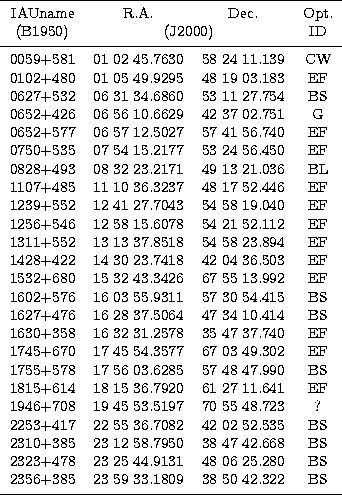Since WENSS was not available when our programme started in 1994, we
adopted a different approach which can be regarded as "opposite" to that
of SSB98 because we started at the high frequencies end instead of
the low one. Hence, to determine candidate GPS sources, we used 8.4 GHz
fluxes from the first part of the Jodrell Bank-VLA Astrometric Survey
(JVAS)![]() (Patnaik et al. 1992) containing all compact radio
sources in the range
(Patnaik et al. 1992) containing all compact radio
sources in the range ![]() with fluxes
>200 mJy at 5 GHz. We combined them with 1.4 GHz and 4.85 GHz fluxes
from the GB catalogues (WB92). For 32 sources 1.4 GHz fluxes were missing
in WB92 so we substituted them with the catalogue flux density limit. Then
we fitted the data with a second order polynomial of the form:
with fluxes
>200 mJy at 5 GHz. We combined them with 1.4 GHz and 4.85 GHz fluxes
from the GB catalogues (WB92). For 32 sources 1.4 GHz fluxes were missing
in WB92 so we substituted them with the catalogue flux density limit. Then
we fitted the data with a second order polynomial of the form:
| (1) |
 BS: blue stell. obj. (without the spec. - basically a quasar) BG: blue galaxy? CW: crowded field - too many objects for a clean identification EF: empty field G: galaxy NS: neutral stell. obj. (same magn. in both E and O prints) OB: obscured field Q: quasar RS: red stellar object. |
This list contained 14 known GPS sources: 0108+388, 0153+744, 0636+680, 0646+600, 0710+439, 0711+356, 1031+567, 1225+368, 1333+459, 1843+356 and 2050+364 listed in OBS91; 0903+684 from Gopal-Krishna & Spoelstra (1993) and two discovered by Snellen et al. (1995) -- 0700+470 and 1324+574. These were not considered for further observations.
We divided the remaining sample of 149 sources into two parts. The first one -- hereinafter "Subsample One'' -- contains those which are found in the 365 MHz Texas survey (24 sources). They are listed in Table 1 along with JVAS positions rounded to 1 milliarcsecond and our identifications made using POSS. Nine of these are also listed in the 6C catalogue which has a flux density limit of 200 mJy at 151 MHz (Hales et al. 1993 and references therein).
For the remaining 125 sources -- hereinafter "Subsample Two'' -- we had virtually no low frequency data. Although 19 of these sources were present in the B3 survey at 408 MHz (Ficarra et al. 1985), its overlap in sky coverage with the first part of the JVAS survey we use here is small and, furthermore, the B3 survey has significant errors in flux density near the catalogue limit of 100 mJy.
The aforementioned crude extrapolation of the spectra applied to medium
and high frequency data (1.4 GHz ![]() 8.4 GHz) of Subsample Two plus
the flux density limit of the Texas Survey gave us only an unreliable estimate
of the frequency turnover and even the convex shape of the spectrum remained
uncertain in some cases. Particularly some weaker sources could either be
GPS or mere flat spectrum depending on whether their 365 MHz fluxes were
far below or just below the Texas catalogue limit respectively. Another
effect that will produce a spurious convex shape in our non-simultaneous
data is the variability typically observed in flat spectrum sources.
8.4 GHz) of Subsample Two plus
the flux density limit of the Texas Survey gave us only an unreliable estimate
of the frequency turnover and even the convex shape of the spectrum remained
uncertain in some cases. Particularly some weaker sources could either be
GPS or mere flat spectrum depending on whether their 365 MHz fluxes were
far below or just below the Texas catalogue limit respectively. Another
effect that will produce a spurious convex shape in our non-simultaneous
data is the variability typically observed in flat spectrum sources.
Copyright The European Southern Observatory (ESO)